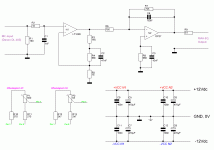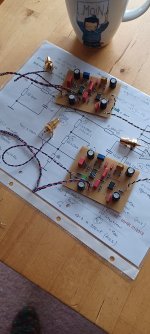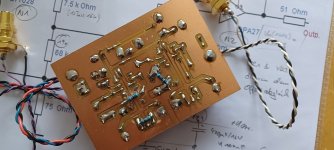At the end of 2017,
I obviously wanted to know whether an LT1028 and an OP27 (or OP37) are suitable for an acceptable, simple and rebuildable EQ.
Probably the motivation was to build a circuit to determine whether it works or not, all the reasons against it are well known - that's why I called the test project "Ice Cold".
Some of my handwritten data:
Overdrive reserve 26dB
RIAA deviation less than +/- 0.1dB
SNR greater than 76dB
THD less than 0.07% (this seems too high to me, but I don't remember under which conditions this value was obtained and with which measuring equipment, sorry)
Gain(1kHz) 60dB
C2 was measured to be greater than 2% and C4 to be less than 1%, all resistors metal film 1%.
The sound was great, open and completely transparent, crisp! Obviously it works fine with a (so often maligned) LT1028.
Kind Regards,
HBt.

I obviously wanted to know whether an LT1028 and an OP27 (or OP37) are suitable for an acceptable, simple and rebuildable EQ.
Probably the motivation was to build a circuit to determine whether it works or not, all the reasons against it are well known - that's why I called the test project "Ice Cold".
Some of my handwritten data:
Overdrive reserve 26dB
RIAA deviation less than +/- 0.1dB
SNR greater than 76dB
THD less than 0.07% (this seems too high to me, but I don't remember under which conditions this value was obtained and with which measuring equipment, sorry)
Gain(1kHz) 60dB
C2 was measured to be greater than 2% and C4 to be less than 1%, all resistors metal film 1%.
The sound was great, open and completely transparent, crisp! Obviously it works fine with a (so often maligned) LT1028.
Kind Regards,
HBt.
Hello Mark T.,And what DC-offset are you expecting at the output?
not always so quick with the young horses 😉.
If you look very closely, you will notice that the DC offset will never be a problem, nor can it be. The entire DC voltage component at the output of the OP27 tends towards zero.
This circuit has no problems whatsoever, it is foolproof. And the signal will certainly hit a high-pass filter of some kind during further processing (preamplifier).
Simply rebuild this simple and completely logical EQ.
greetings,
HBt.
By loading a (40R internal resistance) DL103 with 150R, you have a 2dB attenuator at the input, degrading S/N by 2dB. You might want to increase R1.
@Mark Tillotson
Take a critical look at this equalizer
Minimalistik
which I also call the RIAA integrator.
This implementation really can't be described as stupid, can it?
HBt.
Take a critical look at this equalizer
Minimalistik
which I also call the RIAA integrator.
This implementation really can't be described as stupid, can it?
HBt.
page 13
electrical impedance: 40Ohm +/-20% at 1kHz --> recommended load resistance 100Ohm or more ...
I would add a DC blocking capacitor in series with R6. Even a small DC offset will cause the input selector to pop.
Ed
Ed
Hi Ed,
as soon as I get this equalizer out of the box again, I'll be happy to provide measurements. But nobody really needs to be afraid of a malicious DC at the output of the entire equalizer.
#
You are welcome to connect a subsonic filter or even a simple first-order high-pass filter after R9 if there is no decoupling at all before the multiplexer - but that would be very unusual.
HBt.
as soon as I get this equalizer out of the box again, I'll be happy to provide measurements. But nobody really needs to be afraid of a malicious DC at the output of the entire equalizer.
#
You are welcome to connect a subsonic filter or even a simple first-order high-pass filter after R9 if there is no decoupling at all before the multiplexer - but that would be very unusual.
HBt.
I can only repeat myself, the DC voltage component at the output of the entire DC-coupled circuit tends towards zero. However, if you need to be absolutely on the (unnecessarily) safe side, simply connect a first-order high-pass filter at the end, i.e. a capacitor in series and a cross-resistor to GND, the reference potential.
HBt.
Addendum,
As soon as I have finished playing with the current MM task, I will put the circuit back into operation and report back with the current DC measurement.
HBt.
Addendum,
As soon as I have finished playing with the current MM task, I will put the circuit back into operation and report back with the current DC measurement.
- Home
- Source & Line
- Analogue Source
- "EISKALT", unusal MC-EQ attempt (with two OP-Amplifers)



